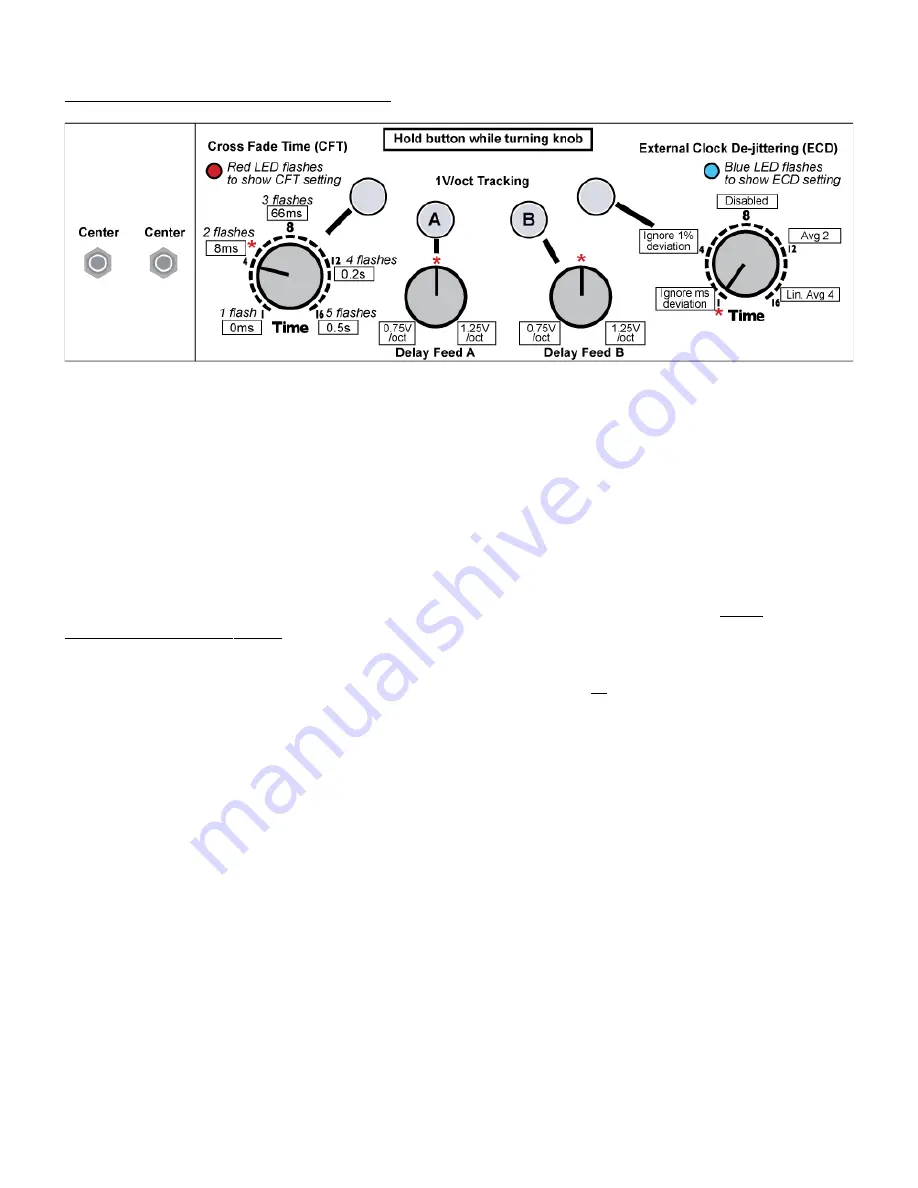
Systems Settings: the ‘Center-Center’ Group
Variable Splice Cross Fade Time (CFT) – NEW FEATURE!
When changing delay time, entering
Reverse
or
Hold
, etc., the natural behavior of a fixed-clock audio delay line such
as the DLD is a discontinuity (click) in audio. The DLD suppresses these by performing a cross-fade between the points
before and after the change. By default, the time of this cross-fade is set at 8 milliseconds. Generally that is enough to
ameliorate artifacts of change but not to audibly affect operation.
In firmware
Version 5
, the time of this crossfade can be adjust by the user, from 0 milliseconds (instant response, but
liable to clicking) to 500 milliseconds, which is quite noticeable and may be too much when delay times are short.
To adjust the
CFT
of the systems, enter the
System Settings
mode, set both toggle switches to the center position,
hold down the
Reverse A
button and adjust the
Time A
control, The red led next to
Time A
flashes to indicate the
approximate value of the CFT
The
CFT
will be stored when you exit the System Settings mode, and will affect all operations. You might like to
experiment to see what effects you can obtain with settings other than the default. For general use, however, we
recommend the
factory default setting of 8 ms
Volt/Octave Tracking Compensation A and B (from Version 4)
The tracking of the
Time CV
jack when the channel is in
Unquantized Time Mode
(See
Owners Manual
for details on
this mode) can be adjusted to compensate for keyboards or sequencers that are not accurate, or to provide alternate
tunings. See the earlier section for a discussion on
Unquantized
Time
Mode
and Resonant Delay patch ideas. When
you flip both the switches to center, the DLD will automatically set the Delay Feed parameter to 100%, so that the
Delay Feed
knobs are free to adjust tracking. Also, the DLD will automatically enter
Unquantized Time
mode. To
calibrate, you should input a clock or VCO of about 50Hz - 100Hz into the Ping jack (the Ping and loop lights will not
flash, that's OK!), turn the
Time
and adjust
Feedback
until you hear a resonant sound. Input a 1V/octave CV signal
into the
Time CV
jack (i.e. from a sequencer or a keyboard).
•Adjust tracking for
Time A CV
jack: Press and hold
Infinite Hold A
while turning the
Delay Feed A
knob
•Adjust tracking for
Time B CV
jack: Press and hold
Infinite Hold B
while turning the
Delay Feed B
knob
Releasing the button will temporarily lock in the value of the knob (this prevents accidentally bumping the knob while
testing the setting). With the
Delay Feed
knob at center, the tracking is 1.00V/octave, at minimum it's 0.75V/octave,
and at maximum it's 1.25V/octave.










